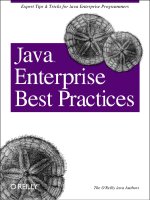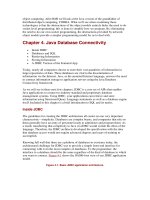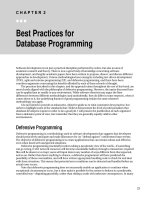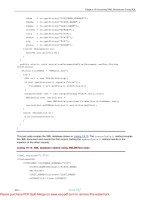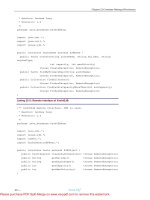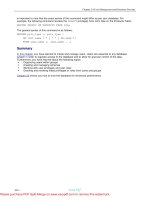java database best apractices
Bạn đang xem bản rút gọn của tài liệu. Xem và tải ngay bản đầy đủ của tài liệu tại đây (4.56 MB, 614 trang )
Main Page
Table of content
Copyright
Dedication
Preface
Audience
Organization of This Book
Conventions Used in This Book
Comments and Questions
About the Philosophers
Acknowledgments
Part I: Data Architecture
Chapter 1. Elements of Database
Applications
1.1 Database Application Architectures
1.2 Component Models
1.3 Persistence Models
Chapter 2. Relational Data Architecture
2.1 Relational Concepts
2.2 Modeling
2.3 Normalization
2.4 Denormalization
2.5 Object-Relational Mapping
Chapter 3. Transaction Management
3.1 Transactions
3.2 Concurrency
3.3 JDBC Transaction Management
3.4 Transaction Management Paradigms
Part II: Persistence Models
Chapter 4. Persistence Fundamentals
4.1 Patterns of Persistence
4.2 A Guest Book Application
Chapter 5. EJB CMP
5.1 Which CMP Model to Use?
5.2 The EJB 1.0 CMP Model
5.3 The EJB 2.0 CMP Model
5.4 Beyond CMP
Chapter 6. EJB BMP
6.1 EJBs Revisited
6.2 BMP Patterns
6.3 State Management
6.4 Exception Handling
Chapter 7. JDO Persistence
7.1 JDO or EJB?
7.2 Basic JDO Persistence
7.3 EJB BMP with JDO
Chapter 8. Alternative Persistence
Frameworks
8.1 Why Alternative Frameworks?
8.2 Persistence Approach
8.3 Persistence Operations
8.4 Searches
8.5 Beyond the Basics
Part III: Tutorials
Chapter 9. J2EE Basics
9.1 The Platform
9.2 Java Naming and Directory Interface
9.3 JavaServer Pages
9.4 Remote Method Invocation
9.5 Enterprise JavaBeans
Chapter 10. SQL
10.1 Background
10.2 Database Creation
10.3 Table Management
10.4 Data Management
Chapter 11. JDBC
11.1 Architecture
11.2 Simple Database Access
11.3 Advanced JDBC
Chapter 12. JDO
12.1 Architecture
12.2 Enhancement
12.3 Queries
12.4 Changes
12.5 Transactions
12.6 Inheritance
Colophon
Index
Index SYMBOL
Index A
Index B
Index C
Index D
Index E
Index F
Index G
Index H
Index I
Index J
Index K
Index L
Index M
Index N
Index O
Index P
Index Q
Index R
Index S
Index T
Index U
Index V
Index W
Index X
• Table of Contents
• Inde x
• Review s
• Examples
• Reader Review s
• Errata
• Acade mic
Java Database Best Practice s
By George Reese
Publisher : O'Reilly
Pub Date : May 2003
ISBN : 0-596-00522-9
Pages : 286
Unlike other books on this topic, which
focus on a single way to do things,
Java Database Best Practices takes
you through a wide variety of different
ways to store and access data,
enabling you to learn which
"persistence model" is most
appropriate for each type of
application. This unique book covers
Enterprise JavaBeans, Java Data
Objects, the Java Database
Connectivity API (JDBC) and other,
lesser-known options.
• Table of Contents
• Index
• Revie w s
• Examples
• Reade r Review s
• Errata
• Acade mic
Java Database Best Practice s
By George Rees e
Publisher : O 'Reilly
Pub Date : May 2003
ISBN : 0-596-00522-9
Pages : 286
Copyright
Dedication
Pre fa ce
Audience
Organization o f This Book
Conventions Use d in This Bo ok
Comments and Questions
About the Philosophers
Acknow le dgments
Part I: Data Architecture
Chapte r 1. Ele ments of Database Applications
Se ction 1.1. Database Applicatio n Architectures
Se ction 1.2. Component Models
Se ction 1.3. Persistence Mode ls
Chapte r 2. Relationa l Data Archite cture
Se ction 2.1. Relational Concepts
Se ction 2.2. Mo de ling
Se ction 2.3. No rmalization
Se ction 2.4. De norma lization
Se ction 2.5. Object-Relationa l Mapping
Chapte r 3. Transaction Management
Se ction 3.1. Transactions
Se ction 3.2. Concurrency
Se ction 3.3. JDBC Tra ns a ction Management
Se ction 3.4. Transaction Manage ment P aradigms
Part II: Pe rsiste nce Mo de ls
Chapte r 4. Persistence Funda me nta ls
Se ction 4.1. Patte rns of Pe rsistence
Se ction 4.2. A Gues t Book Application
Chapte r 5. EJB C MP
Se ction 5.1. W hich CMP Model to Use ?
Se ction 5.2. The EJB 1.0 CMP Mode l
Se ction 5.3. The EJB 2.0 CMP Mode l
Se ction 5.4. Beyond CMP
Chapte r 6. EJB BMP
Se ction 6.1. EJBs Revisited
Se ction 6.2. BMP Patterns
Se ction 6.3. State Ma nagement
Se ction 6.4. Exception Handling
Chapte r 7. JDO Persistence
Se ction 7.1. JDO or EJB?
Se ction 7.2. Bas ic JDO P ers istence
Se ction 7.3. EJB BMP w ith JDO
Chapte r 8. Alte rnative Pers iste nce Framew orks
Se ction 8.1. W hy Alternative Framew orks?
Se ction 8.2. Persistence Approach
Se ction 8.3. Persistence Opera tions
Se ction 8.4. Se a rches
Se ction 8.5. Beyond the Ba s ics
Part III: Tutorials
Chapte r 9. J2EE Basics
Se ction 9.1. The Platform
Se ction 9.2. Java Naming and Directo ry Interfa ce
Se ction 9.3. JavaServe r Page s
Se ction 9.4. Remote Me tho d Invocation
Se ction 9.5. Enterprise JavaBe ans
Chapte r 10. SQL
Se ction 10.1. Backgro und
Se ction 10.2. Database C reation
Se ction 10.3. Table Ma nagement
Se ction 10.4. Data Ma na ge ment
Chapte r 11. JDBC
Se ction 11.1. Archite cture
Se ction 11.2. Simple Database Access
Se ction 11.3. Advance d JDBC
Chapte r 12. JDO
Se ction 12.1. Archite cture
Se ction 12.2. Enhance ment
Se ction 12.3. Queries
Se ction 12.4. Changes
Se ction 12.5. Transactions
Se ction 12.6. Inherita nce
Colophon
Index
Copyright
Copyright © 2003 O'Reilly & Associates, Inc.
Printed in the United States of America.
Published by O'Reilly & Associates, Inc., 1005
Gravenstein Highway North, Sebastopol, CA
95472.
O'Reilly & Associates books may be purchased
for educational, business, or sales promotional
use. Online editions are also available for most
titles (). For more
information, contact our corporate/institutional
sales department: (800) 998-9938 or
Nutshell Handbook, the Nutshell Handbook logo,
and the O'Reilly logo are registered trademarks
of O'Reilly & Associates, Inc. Java and all Java-
based trademarks and logos are trademarks or
registered trademarks of Sun Microsystems, Inc.,
in the United States and other countries. O'Reilly
& Associates, Inc. is independent of Sun
Microsystems. The licenses for all the open
source tools presented in this book are included
with the online examples. Many of the
designations used by manufacturers and sellers
to distinguish their products are claimed as
trademarks. W here those designations appear in
this book, and O'Reilly & Associates, Inc. was
aware of a trademark claim, the designations
have been printed in caps or initial caps. The
association between the image of a taguan and
the topic of Java database best practices is a
trademark of O'Reilly & Associates, Inc.
W hile every precaution has been taken in the
preparation of this book, the publisher and
authors assume no responsibility for errors or
omissions, or for damages resulting from the use
of the information contained herein.
Dedication
T o my beautiful w ife, Monique, and the
child she carries.
It is never too late to become reasonable
and w ise; but if the insight comes late,
there is alw ays more difficulty in starting
the change.
Immanuel Kant, Prolegomena to Any Future
Metaphysics
Java database programming has grown much
more complex than it was in 1996 when I wrote
the first edition of my book Database
Programming w ith JDBC and Java (O'Reilly &
Associates). The J2EE platform did not exist.
Distributed programming was RMI, JDBC was
simple, and transaction management and
persistence did not exist in the Java vocabulary.
Database programming in 1996 was quite simply
JDBC programming.
To place database programming in a real-world
context, I spent much of that book introducing
ways to build robust persistence models and
manage transactions using only the JDBC API. As
you can imagine, you had to do a lot of things
for yourself that developers now take for granted
in the Java platform.
The Java world has certainly changed since then.
Not only does Java provide you with a
persistence model, it provides you with three
different persistence models built right into the
core J2EE platform. Outside the J2EE platform is
the popular JDO persistence model. In addition,
many tools exist to enable you to effectively use
third-party and custom persistence models. All of
these choices present a problem for database
programmers that simply did not exist in 1996:
what are the best approaches to database
programming with the Java language?
This book seeks to aid the Java developer in
appreciating the different approaches Java
provides for database programming. It helps you
assess what approaches fit which problems, and
what the best practices are under each model.
Audience
This book is not an introductory text. It is also
not a tutorial on any particular API. It is,
instead, a description of the best practices for
using a database to drive a variety of Java
application architectures. It assumes you have
at least a passing familiarity with one or more of
the Java enterprise APIs, as well as SQL. Y ou do
not, however, need to be an expert in all of
them. To help you with any holes in your
knowledge of these tools, I provide a few
tutorial chapters at the end of the book.
Organization of This Book
This book is divided into three distinct sections.
The first two sections are the meat of this book:
best practices for Java database architecture and
development. The first section focuses on the
architecture aspect and the second section on
the development aspect.
Part I
Chapter 1 is an overview of the art of database
programming. It examines the various tools and
skills needed for database programming and
covers common database application
architectures. The chapter is mostly review
material for experienced database programmers.
Chapter 2 tackles one of the more difficult
aspects of database programming, especially for
the object-oriented programmer: data
architecture. This chapter begins with relational
theory and covers critical topics such as
normalization and object-relational modeling. It
is a very important chapter for database
programmers of all levels of experience.
Though relational architecture is one of the more
difficult aspects of database programming,
transaction management is where database
programmers make most of their mistakes.
Chapter 3 covers transactions and transaction
management.
Part II
The second section begins with an overview of
persistence concepts. In short, persistence is
the practice of saving application state to a data
store. Chapter 4 introduces this practice with an
eye on using relational databases as your data
store for Java applications.
Chapter 5 through Chapter 8 go into the best
practices for different Java persistence models.
Chapter 5 begins with container-managed
persistence under the Enterprise JavaBeans
component modelfor Versions 1 and 2. Chapter 6
tackles the other EJB persistence model, bean-
managed persistence. Chapter 7 dives into an
evolving, popular persistence model, Java Data
Objects. Finally, Chapter 8 looks at alternatives
to the standard Java persistence models.
Part III
The third section of the book contains tutorials
on the core technologies covered in this book.
No reader should need to read all of the tutorial
chapters. Instead, I expect that most readers
will be familiar with the subject in several, but
not all, of the tutorial chapters. The tutorial
chapters provide the basic knowledge necessary
to understand key concepts used in the first two
sections. Don't look to any of the tutorial
chapters to make you an expert in its subject
matter. I have provided tutorials on the J2EE
platform (Chapter 9), SQL (Chapter 10), JDBC
(Chapter 11), and JDO (Chapter 12).
I recommend reading the first two sections in
order, breaking that order only to refer to a
tutorial chapter for a subject on which you lack
familiarity.
Conventions Used in This Book
The following typographical conventions are used
in this book:
I ta lic
Used for filenames and directory names,
programs, compilers, tools, utilities, URLs,
emphasis, and first use of a technical term.
Constant width
Used in code examples and to show the
contents of files. Also used for tags,
attributes, and environment variable names
appearing in the text.
Constant width italic
Used as a placeholder to indicate an item
that should be replaced with an actual value
in your program.
Constant width bold
Used to highlight a particular section or
change in code, such as a custom tag or a
change in a transaction.
Comments and Questions
Please address comments and questions
concerning this book to the publisher:
O'Reilly & Associates, Inc.
1005 Gravenstein Highway North
Sebastopol, CA 95472
(800) 998-9938 (in the United States or
Canada)
(707) 829-0515 (international/local)
(707) 829-0104 (fax)
There is a web page for this book, which lists
errata, examples, or any additional information.
Y ou can access this page at:
/>To comment or ask technical questions about
this book, send email to:
For more information about books, conferences,
Resource Centers, and the O'Reilly Network, see
the O'Reilly web site at:
